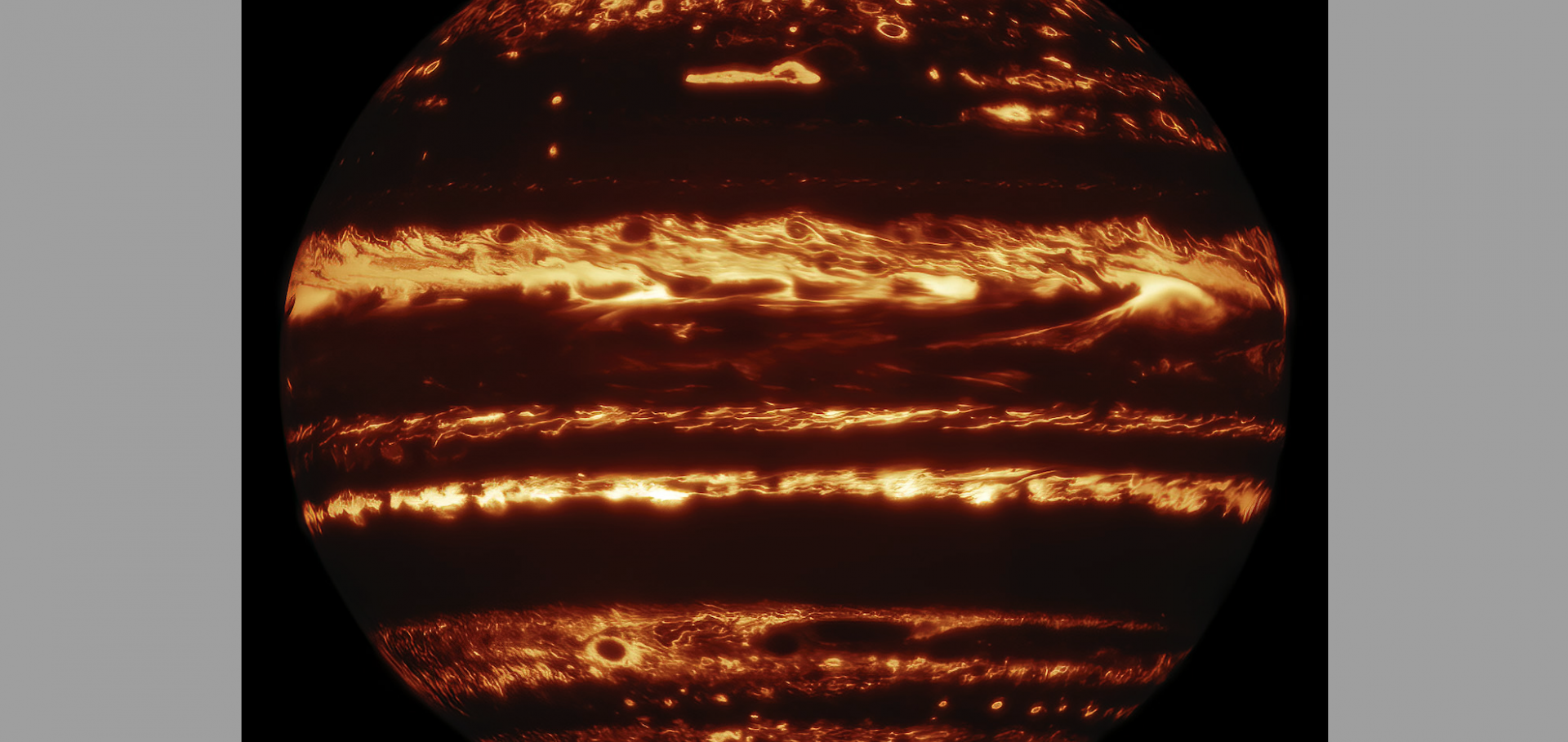Atmospheric dynamics of hot giant planets and brown dwarfs
Space Science Reviews Springer 216:8 (2020) 139
Abstract:
Groundbased and spacecraft telescopic observations, combined with an intensive modeling effort, have greatly enhanced our understanding of hot giant planets and brown dwarfs over the past ten years. Although these objects are all fluid, hydrogen worlds with stratified atmospheres overlying convective interiors, they exhibit an impressive diversity of atmospheric behavior. Hot Jupiters are strongly irradiated, and a wealth of observations constrain the day-night temperature differences, circulation, and cloudiness. The intense stellar irradiation, presumed tidal locking and modest rotation leads to a novel regime of strong day-night radiative forcing. Circulation models predict large day-night temperature differences, global-scale eddies, patchy clouds, and, in most cases, a fast eastward jet at the equator—equatorial superrotation. The warm Jupiters lie farther from their stars and are not generally tidally locked, so they may exhibit a wide range of rotation rates, obliquities, and orbital eccentricities, which, along with the weaker irradiation, leads to circulation patterns and observable signatures predicted to differ substantially from hot Jupiters. Brown dwarfs are typically isolated, rapidly rotating worlds; they radiate enormous energy fluxes into space and convect vigorously in their interiors. Their atmospheres exhibit patchiness in clouds and temperature on regional to global scales—the result of modulation by large-scale atmospheric circulation. Despite the lack of irradiation, such circulations can be driven by interaction of the interior convection with the overlying atmosphere, as well as self-organization of patchiness due to cloud-dynamical-radiative feedbacks. Finally, irradiated brown dwarfs help to bridge the gap between these classes of objects, experiencing intense external irradiation as well as vigorous interior convection. Collectively, these diverse objects span over six orders of magnitude in intrinsic heat flux and incident stellar flux, and two orders of magnitude in rotation rate—thereby placing strong constraints on how the circulation of giant planets (broadly defined) depend on these parameters. A hierarchy of modeling approaches have yielded major new insights into the dynamics governing these phenomena.Atmospheric circulation of tidally locked gas giants with increasing rotation and implications for white-dwarf-brown-dwarf systems
Astrophysical Journal IOP Publishing 902:1 (2020) 27
Abstract:
Tidally locked gas giants, which exhibit a novel regime of day–night thermal forcing and extreme stellar irradiation, are typically in several-day orbits, implying a modest role for rotation in the atmospheric circulation. Nevertheless, there exist a class of gas-giant, highly irradiated objects—brown dwarfs orbiting white dwarfs in extremely tight orbits—whose orbital and hence rotation periods are as short as 1–2 hr. Phase curves and other observations have already been obtained for this class of objects, raising fundamental questions about the role of an increasing planetary rotation rate in controlling the circulation. So far, most modeling studies have investigated rotation periods exceeding a day, as appropriate for typical hot Jupiters. In this work, we investigate atmospheric circulation of tidally locked atmospheres with decreasing rotation periods (increasing rotation rate) down to 2.5 hr. With a decreasing rotation period, we show that the width of the equatorial eastward jet decreases, consistent with the narrowing of the equatorial waveguide due to a decrease of the equatorial deformation radius. The eastward-shifted equatorial hot-spot offset decreases accordingly, and the off-equatorial westward-shifted hot areas become increasingly distinctive. At high latitudes, winds become weaker and more rotationally dominated. The day–night temperature contrast becomes larger due to the stronger influence of rotation. Our simulated atmospheres exhibit variability, presumably caused by instabilities and wave interactions. Unlike typical hot Jupiter models, the thermal phase curves of rapidly rotating models show a near alignment of peak flux to secondary eclipse. This result helps to explain why, unlike hot Jupiters, brown dwarfs closely orbiting white dwarfs tend to exhibit IR flux peaks nearly aligned with secondary eclipse. Our results have important implications for understanding fast-rotating, tidally locked atmospheres.Atmospheric Circulation of Tidally Locked Gas Giants with Increasing Rotation and Implications for White Dwarf-Brown Dwarf Systems
ASTROPHYSICAL JOURNAL American Astronomical Society 902:1 (2020) ARTN 27
Abstract:
© 2020. The American Astronomical Society. All rights reserved. Tidally locked gas giants, which exhibit a novel regime of day–night thermal forcing and extreme stellar irradiation, are typically in several-day orbits, implying a modest role for rotation in the atmospheric circulation. Nevertheless, there exist a class of gas-giant, highly irradiated objects—brown dwarfs orbiting white dwarfs in extremely tight orbits—whose orbital and hence rotation periods are as short as 1–2 hr. Phase curves and other observations have already been obtained for this class of objects, raising fundamental questions about the role of an increasing planetary rotation rate in controlling the circulation. So far, most modeling studies have investigated rotation periods exceeding a day, as appropriate for typical hot Jupiters. In this work, we investigate atmospheric circulation of tidally locked atmospheres with decreasing rotation periods (increasing rotation rate) down to 2.5 hr. With a decreasing rotation period, we show that the width of the equatorial eastward jet decreases, consistent with the narrowing of the equatorial waveguide due to a decrease of the equatorial deformation radius. The eastward-shifted equatorial hot-spot offset decreases accordingly, and the off-equatorial westward-shifted hot areas become increasingly distinctive. At high latitudes, winds become weaker and more rotationally dominated. The day–night temperature contrast becomes larger due to the stronger influence of rotation. Our simulated atmospheres exhibit variability, presumably caused by instabilities and wave interactions. Unlike typical hot Jupiter models, the thermal phase curves of rapidly rotating models show a near alignment of peak flux to secondary eclipse. This result helps to explain why, unlike hot Jupiters, brown dwarfs closely orbiting white dwarfs tend to exhibit IR flux peaks nearly aligned with secondary eclipse. Our results have important implications for understanding fast-rotating, tidally locked atmospheres.Simplified 3D GCM modelling of the irradiated brown dwarf WD 0137−349B
Monthly Notices of the Royal Astronomical Society Oxford University Press 496:4 (2020) 4674-4687
Abstract:
White dwarf–brown dwarf short-period binaries (Porb ≲ 2 h) are some of the most extreme irradiated atmospheric environments known. These systems offer an opportunity to explore theoretical and modelling efforts of irradiated atmospheres different to typical hot Jupiter systems. We aim to investigate the three-dimensional (3D) atmospheric structural and dynamical properties of the brown dwarf WD 0137−349B. We use the 3D global circulation model (GCM) Exo-Flexible Modelling System (FMS) with a dual-band grey radiative transfer scheme to model the atmosphere of WD 0137−349B. The results of the GCM model are post-processed using the 3D Monte Carlo radiative transfer model CMCRT. Our results suggest inefficient day–night energy transport and a large day–night temperature contrast for WD 0137−349B. Multiple flow patterns are present, shifting energy asymmetrically eastward or westward depending on their zonal direction and latitude. Regions of overturning are produced on the western terminator. We are able to reproduce the start of the system near-infrared (IR) emission excess at ≳1.95 μm as observed by the Gemini Near-Infrared Spectrograph (GNIRS) instrument. Our model overpredicts the IR phase curve fluxes by factors of ≈1–3, but generally fits the shape of the phase curves well. Chemical kinetic modelling using VULCAN suggests a highly ionized region at high altitudes can form on the dayside of the brown dwarf. We present a first attempt at simulating the atmosphere of a short-period white dwarf–brown dwarf binary in a 3D setting. Further studies into the radiative and photochemical heating from the ultraviolet irradiation are required to more accurately capture the energy balance inside the brown dwarf atmosphere. Cloud formation may also play an important role in shaping the emission spectra of the brown dwarf.Evidence for H2 dissociation and recombination heat transport in the atmosphere of KELT-9b
Astrophysical Journal Letters American Astronomical Society 888:2 (2020) L15


